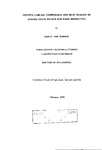GROWTH, CARCASS COMPOSITION AND MEAT QUALITY OF ANGORA GOATS REARED FOR FIBRE PRODUCTION
| dc.contributor.author | BARBER, SARAH ANN | |
| dc.contributor.other | Faculty of Science and Engineering | en_US |
| dc.date.accessioned | 2013-11-14T10:02:30Z | |
| dc.date.available | 2013-11-14T10:02:30Z | |
| dc.date.issued | 1995 | |
| dc.identifier | NOT AVAILABLE | en_US |
| dc.identifier.uri | http://hdl.handle.net/10026.1/2704 | |
| dc.description.abstract |
The effects of age and plane of nutrition on the body and carcass composition and mohair fibre yield and quality of British Angora wether goats slaughtered at six, 12, 18 and 24 months of age were investigated. Carcass yield, composition and conformation improved with increasing age and plane of nutrition. Greasy fleece weight also increased with increasing age and plane of nutrition but fibre quality declined since the increase in mass was achieved by means of increased fibre diameter with no effect of age or plane of nutrition on the fibre elongation rate. There was a constant relationship between the increase in fibre diameter with age and fleece mass which was not affected by plane of nutrition. Similarly there was no significant effect of plane of nutrition on the relationships between fibre diameter and the weight of various body and carcass components. A strong relationship between fibre diameter and the weight of fat in the body or carcass suggested that the increase in fibre diameter with age of the goat was influenced by cumulative feed intake rather than by fat-free body size. The allometric growth patterns of the body and carcass of the Angora goat conformed with the patterns established for other domestic species, with early maturity of the external offal and vital organs, later maturity of the carcass and body fat, and a centripetal pattern of development. There was no effect of plane of nutrition on the allometric growth patterns of the fat-free body or carcass, but decreasing the plane of nutrition resulted in a uniform retardation of all body parts and carcass tissues and a significant effect on the relative growth rate of body and carcass fat. Regression equations were formulated to predict the half carcass composition of Angora wether goats using sample joint dissection data. The most accurate predictions were achieved with data from the leg and the best end of neck combined in multiple regression equations. A second experiment to investigate the effects of long term undernutrition followed by realimentation on the growth rate and composition of empty body weight gain revealed no evidence of compensatory liveweight gain in the Angora goat. | en_US |
| dc.language.iso | en | en_US |
| dc.publisher | University of Plymouth | en_US |
| dc.title | GROWTH, CARCASS COMPOSITION AND MEAT QUALITY OF ANGORA GOATS REARED FOR FIBRE PRODUCTION | en_US |
| dc.type | Thesis | |
| plymouth.version | Full version | en_US |
| dc.identifier.doi | http://dx.doi.org/10.24382/3448 |
Files in this item
This item appears in the following Collection(s)
-
01 Research Theses Main Collection
Research Theses Main


